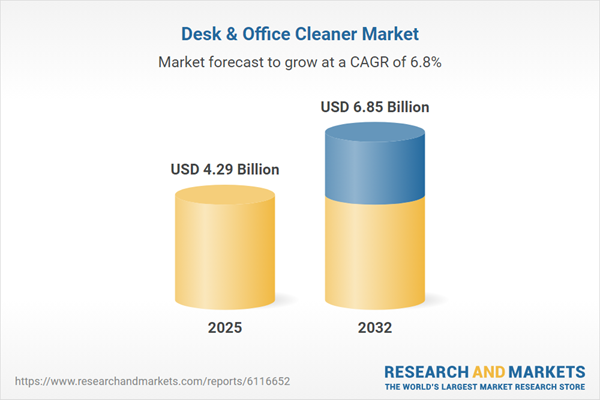Speak directly to the analyst to clarify any post sales queries you may have.
The desk and office cleaner market is undergoing rapid transformation, shaped by evolving workplace standards, technological advancements, and increased focus on safety and sustainability. These factors are changing procurement priorities and reshaping decision criteria for organizations investing in facility hygiene solutions.
Market Snapshot: Desk & Office Cleaner Market Growth and Outlook
The Desk & Office Cleaner Market grew from USD 4.03 billion in 2024 to USD 4.29 billion in 2025. With a projected compound annual growth rate (CAGR) of 6.84%, it is expected to reach USD 6.85 billion by 2032. This robust trajectory demonstrates expanding demand among commercial and residential users as workplace well-being and cleanliness become top priorities for businesses globally.
Scope & Segmentation: Comprehensive Market Coverage
This research dissects the desk and office cleaner market across product types, packaging, applications, end users, distribution channels, and regions. The segmentation offers deep insight into buyer behavior and procurement shifts:
- Product Type: Foam cleaners, liquid cleaners (including concentrates, refills, and ready-to-use products), spray cleaners (degreasers, disinfectants, general purpose), wipes (alcohol-based and non-alcohol-based).
- Packaging Type: Aerosol cans, sachets, glass bottles, and plastic bottles.
- Application: Disinfecting, grease removal, polishing and shining, surface cleaning.
- End User: Commercial, government and institutional, and residential segments.
- Distribution Channel: Offline retail (specialty stores, supermarkets, hypermarkets) and online retail (company websites, e-commerce platforms).
- Regional Coverage:
- Americas: United States, Canada, Mexico, Brazil, Argentina, Chile, Colombia, Peru
- Europe, Middle East & Africa: United Kingdom, Germany, France, Russia, Italy, Spain, Netherlands, Sweden, Poland, Switzerland, United Arab Emirates, Saudi Arabia, Qatar, Turkey, Israel, South Africa, Nigeria, Egypt, Kenya
- Asia-Pacific: China, India, Japan, Australia, South Korea, Indonesia, Thailand, Malaysia, Singapore, Taiwan
- Leading Companies: Covers 3M, Amway Corporation, Arrow Solutions, Betco Corporation, Bombril S/A, Church & Dwight Co. Inc., Colgate‑Palmolive Company, Diversey Holdings, Dober Chemical Corp., Ecolab Inc., Gojo Industries, Henkel AG, Kao Corporation, Kimberly‑Clark Corporation, Reckitt Benckiser, Royal Chemical Co., S.C. Johnson & Son Inc., Sealed Air Corporation, Spartan Chemical, Tennant Company, The Clorox Company, The Procter & Gamble Company, Unilever, Weiman Products, Zep, Inc.
Key Takeaways for Decision-Makers
- Advanced cleaning solutions are now integral for workplace productivity and employee health as buyers demand rapid-action and surface-safe products.
- Technological innovation drives next-generation dispensing systems and integration with facility management platforms, supporting resource efficiency.
- Sustainability initiatives shape both product composition and packaging design, with buyers gravitating toward eco-friendly and low-emission alternatives.
- Digitalization of procurement and data transparency allow stakeholders to evaluate performance, certifications, and environmental credentials with greater accuracy.
- Regional differences, from regulatory variances in Europe to demand growth in Asia-Pacific, require tailored product portfolios and local market strategies.
- Major industry players compete through innovation, partnerships, and strategic acquisitions, but emerging regional and niche brands offer localized solutions and sustainable chemistries.
Tariff Impact and Supply Chain Adjustments
Recent tariff policies, especially those implemented by the United States on imported raw materials, have contributed to higher production costs throughout the supply chain. Industry participants have responded by consolidating manufacturing sites, strengthening regional sourcing, and renegotiating supply contracts to mitigate volatility and ensure reliable order fulfillment. Diversifying supplier networks and exploring cost-containment strategies remain critical to navigating ongoing tariff uncertainty.
Methodology & Data Sources
This market analysis combines primary and secondary research. In-depth interviews with executives, chemists, supply chain professionals, and sustainability experts form the primary data. Secondary analysis integrates industry publications, regulatory filings, patent documents, and consumer surveys. Data triangulation and validation protocols enhance reliability and comprehensiveness.
Why This Report Matters: Strategic Decision Support
- Enables detailed benchmarking of product, technology, and channel trends relevant to procurement and product development teams.
- Equips executives with actionable insights for risk mitigation, sustainability planning, and market-entry or expansion strategies.
- Facilitates transparent evaluation of competitors and partners, with focus on regulatory alignment and supply chain adaptability.
Conclusion
Growth in the desk and office cleaner market reflects transformative trends in workplace hygiene, sustainability, and digital enablement. Strategic adaptation will position stakeholders to address emerging challenges, shape product portfolios, and secure competitive advantage in a dynamic environment.
Table of Contents
3. Executive Summary
4. Market Overview
7. Cumulative Impact of Artificial Intelligence 2025
Companies Mentioned
The companies profiled in this Desk & Office Cleaner market report include:- 3M Company
- Amway Corporation
- Arrow Solutions
- Betco Corporation
- Bombril S/A
- Church & Dwight Co. Inc.
- Colgate‑Palmolive Company
- Diversey Holdings, Ltd.
- Dober Chemical Corp.
- Ecolab Inc.
- Gojo Industries, Inc.
- GOJO Industries, Inc.
- Henkel AG & Co. KGaA
- Kao Corporation
- Kimberly‑Clark Corporation
- Reckitt Benckiser Group Plc
- Royal Chemical Co.
- S. C. Johnson & Son Inc.
- Sealed Air Corporation
- Spartan Chemical Company, Inc.
- Tennant Company
- The Clorox Company
- The Procter & Gamble Company
- Unilever Plc
- Weiman Products, LLC
- Zep, Inc.
Table Information
| Report Attribute | Details |
|---|---|
| No. of Pages | 196 |
| Published | November 2025 |
| Forecast Period | 2025 - 2032 |
| Estimated Market Value ( USD | $ 4.29 Billion |
| Forecasted Market Value ( USD | $ 6.85 Billion |
| Compound Annual Growth Rate | 6.8% |
| Regions Covered | Global |
| No. of Companies Mentioned | 27 |









